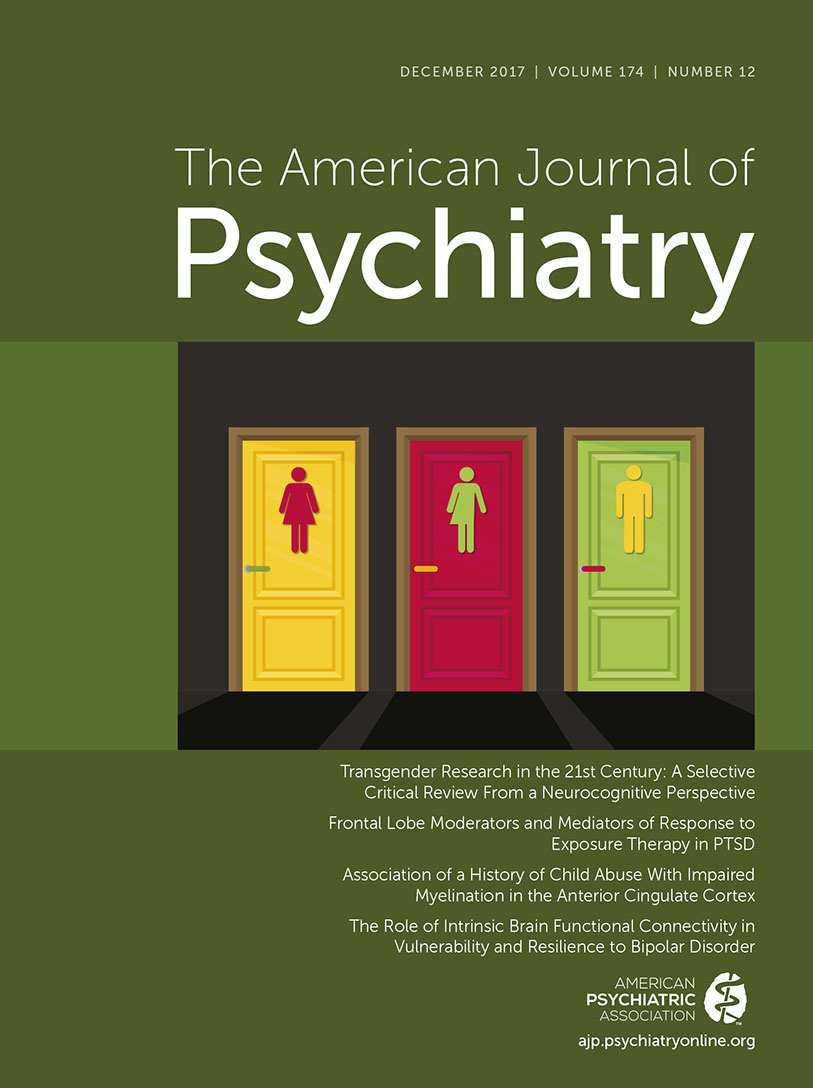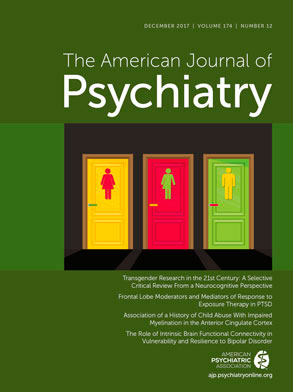The Editors are pleased to offer personal selections of some of the articles they found particularly interesting and important in this year’s Journal.
Treating Depression in Children and Adolescents
No treatment in our field, from psychoanalysis to psychopharmaceuticals, is free of controversy. An important role of the
Journal’s research articles is to present the current scientific evidence that supports or refutes the use of treatments for psychiatric illnesses. Scientific controversies are the crucible from which new insights and better treatments emerge. However, a second role that the
Journal takes equally if not more seriously is to ensure, above the noise of the debate, that patients and their families and physicians have clear guidance for their decisions about treatment of patients’ illnesses. Controversy has swirled around the treatment of depression in children and adolescents for the past decade, from black box warnings for suicide to more recent questioning of the influence of pharmaceutical companies in reporting the results of the initial clinical trials that are required before the company is permitted by the Food and Drug Administration to market the drug. The Editors wanted to give our readers perspective on whether these controversies should affect their treatment of patients with depression. We therefore asked John T. Walkup, one of the most experienced experts on clinical trials in children and adolescents, to review the data that support or refute antidepressant treatment (
1). In his review article “Antidepressant Efficacy for Depression in Children and Adolescents: Industry- and NIMH-Funded Studies,” Dr. Walkup discusses initial industry-sponsored trials, the recent wave of inconclusive but highly publicized meta-analyses, and the definitive trials sponsored by the National Institute of Mental Health (NIMH). He points out that many industry trials have flaws caused by the recruitment of large numbers of patients at research sites where evaluators may be hastily trained. The problem is compounded by subsequent meta-analyses that fail to exclude poorly administered trials. These meta-analyses often report equivocal effects and are then used to advocate that the treatments are ineffective. Because of these problems, a broad group of psychiatric researchers successfully advocated to NIMH several decades ago that it sponsor independent, well-conducted, peer-reviewed trials of all major psychiatric treatments, including antidepressants for children and adolescents.
The American Journal of Psychiatry and other major journals in our field have reported the results of the trials, which support the value of antidepressant treatment of children and adolescents with serious depressions. Dr. Walkup carefully highlights these trials and presents the soundness of their conduct and the robustness of their results. I can think of no higher duty of our profession and the
Journal than to deliver to families and doctors, as clearly as possible, the information that will best inform their decision on how to treat children.
A 21st Century Perspective on Psychiatric Nosology of the 19th Century
A basic goal of psychiatric research is clinically actionable knowledge. What can we learn that will make a difference to our patients? An understanding of etiology is essential, but there are differences regarding the optimal strategy to achieve that goal. Some argue for increasingly refined study of psychopathology and diagnosis. Their flag is the several DSMs. Others believe that successive attempts to move from diagnostic categories to understanding etiology have been disappointing, and that a new strategy is needed. They argue that we should directly attack the most promising research areas for the etiology of psychiatric illnesses. Their flag is the Research Domain Criteria (RDoC) developed at NIMH under the leadership of Thomas Insel. The two strategies are not incompatible, but each is expensive and resources are limited.
The article I am highlighting is an historical review that at first glance seems far removed from this contemporary debate but in fact is fundamental to it. Kenneth Kendler is a leading psychiatric researcher, a genetic epidemiologist, who played a major role in the development in DSM-5. Eric Engstrom is a distinguished historian of psychiatry. They discuss the evolution of psychiatric diagnosis in the late 19th and early 20th centuries, with the shift from earlier symptom-based concepts (think fever, headache, dropsy, confusion) to proto-disease entities that encompass symptom clusters, but importantly include outcome, course of illness, precursors, and prognosis (
3). Kahlbaum and Hecker, working in a private sanatorium that specialized in the treatment of young patients, formulated disease entities—hebephrenia, catatonia, and cyclic insanity. Kraepelin, an academic psychiatrist working in a university clinic, adapted and expanded their ideas, further emphasizing the importance of course and outcome. The goal was clear—to identify clinical entities that would lead to the discovery of etiology. It was modeled on the spectacular success in the study of infectious diseases, such as tuberculosis, in the 19th century, which was about to be successful in psychiatry with the 1913 discovery of the spirochete in general paralysis. Kahlbaum, Hecker, and Kraepelin argued against their contemporary Wernicke, who had advocated a direct research attack on the brain, the 19th century’s major candidate for the domain of etiology. Think DSM versus RDoC.
It is now more than 100 years since Noguchi discovered the spirochete, and we have yet to achieve a similar victory. Kraepelin and colleagues thought that general paresis of the insane was the prototype, but perhaps it was the exception. Most major psychiatric disorders reflect a complex mixture of genetic, environmental, psychosocial, and developmental factors. We need strategies that will allow us to integrate Kraepelin, Wernicke, and Noguchi and draw upon both clinical knowledge and basic science. Kendler and Engstrom advocate “an iterative process in which the mutual strengths of the available fallible clinical and biological tools interact[ed] synergistically on nosologic problems”—a marriage of DSM and RDoC.
Advancing Brain Imaging Through Collaboration
Recent brain imaging studies define hurdles to overcome before the techniques can become clinically useful. One such hurdle relates to the need for large samples that combine data from patients seen in diverse settings. Boedhoe and colleagues (
4) help the field to approach this hurdle by reporting new data from a meta-analysis on brain volumes in more than 3,000 individuals, approximately half with a diagnosis of obsessive-compulsive disorder (OCD).
The findings are important both because they illustrate a path for other imaging meta-analytic studies and because they inform understandings of OCD. Findings appeared similar to those from other imaging studies with large samples of mood or anxiety disorder patients, in that effect sizes were generally small. Moreover, both medication treatment history and the age of the patient powerfully modulated the results. Researchers can have more confidence in such modulatory findings when they are based in large samples such as the one reported by Boedhoe and colleagues. Such work highlights the need to redouble our efforts to work collaboratively among research groups when conducting brain imaging research.
When the SSRIs Do Not Work—Choose Wisely
Nelson and Spyker (
5) summarize U.S. Poison Control Center (2000–2014) data by calculating morbidity and mortality indices for 48 medications used to treat depression for all persons—at least 12 years of age—including antidepressants, atypical antipsychotics, anticonvulsants, lithium, and other medications. The morbidity (number of serious outcomes per 1,000 exposures) and mortality (number of fatal outcomes per 10,000 exposures) indices were estimated for each medication based on nearly 1 million exposures.
From 2000 to 2014, the U.S. suicide rate rose 25%, from 10.4 to 13.0 deaths per 100,000, but suicides from poisonings rose by an even higher rate (38.5%) in a clearly linear manner. Why this increase? A greater recognition of depression, greater appropriate and inappropriate use of antidepressant medications, the use of larger amounts of medications on refill orders, less frequent medication visits, or greater use of many other medications (e.g., opioids) could be causes.
This report (
5) allows readers to compare different medications in terms of morbidity and mortality. Tricyclics and MAOIs had high morbidity and mortality indices. Lithium, quetiapine, olanzapine, bupropion, and carbamazepine had higher morbidity indices, while lithium, venlafaxine, bupropion, quetiapine, olanzapine, ziprasidone, valproic acid, and citalopram had higher mortality indices.
Psychiatrists and other mental health specialists are seeing more and more patients for whom the safer and easier-to-use SSRIs have often failed. For these patients, we have to select among the more risky and tougher-to-take medications—whether augmenting or switching. Furthermore, patients who fare poorly on the first treatment step are likely to have more concurrent general medical or psychiatric conditions (
6), have substantial suicidal risk, and be taking other medications. The resulting polypharmacy can raise both morbidity and mortality indices.
The report helps us to choose a bit more wisely as it details the serious side effects found with these medications in poisonings/overdoses in the “real world” based on cardiovascular, neurological, and other systems from the Poison Control Center call-ins. Tables in the article provide a basis for comparing among the atypical antipsychotics, tricyclic agents, MAOIs, and other medication groups. In addition, their results suggest strongly that off-label use of medications that have high morbidity or mortality indices should be avoided. Amitriptyline for pain or sleep, for example, is not sensible when less toxic and risky options are available.
Beyond these clinical implications for selecting among the non-SSRI agents, this report underlines—in my view—the potential high clinical value of patient registries or electronic health records in which the reporting of adverse events is a requirement. Such an effort would be a great help in defining which agents might be best accepted, least burdensome, and safer in the difficult-to-treat depressed patients seeing mental health specialists. The adverse effects of our medications cannot be estimated accurately from trials that are conducted for regulatory purposes due to the need to optimize internal validity (
7). Care systems now require clinicians to record a host of accounting and billing variables. Why don’t we push for mandatory recording of information that we can use to help patients as well?
How Many Should We Expect?
Now that the prospect of early, effective treatment for psychosis is at our doorstep, we are beholden to reliably detect early psychosis cases as close to the start of their illness as possible. So, understanding the epidemiology of first-episode psychosis is imperative for psychiatry. And we have not been very good at early detection in the past. In the article by Kirkbride et al. (
9), we see a nicely executed example of early psychosis epidemiology from a country where early detection is well established and assessment is direct, especially for this condition. The crude incidence of 34.0 cases per 100,000 person-years for all psychoses, of which 50.9% (28.3 per 100,000 person-years) is nonaffective psychosis, is their answer. Moreover, this incidence is further supported by the male/female age at onset, by increased incidence for ethnic minorities and lower socioeconomic groups, as well as the urban neighborhood predominance. Because detection is not well established (yet) in the U.S., these are the estimates that we will use to measure our identification success for detecting first-episode psychosis in the near future.
From the AJP Residents’ Journal: Adverse Symptoms Versus Adverse Circumstances
As this year’s Editor-in-Chief of the most widely read resident-run journal in American medicine, I will continue our commitment to psychiatry trainees, our field's next generation. This year,
The American Journal of Psychiatry Residents’ Journal has searched for the stories of trainees amidst a time burdened by natural and manmade crises. We are preparing journal issues focused on substance abuse and forensic psychiatry, especially relevant of late. We are also introducing new features such as “Medicine for the Psychiatrist,” “Perspectives in Global Mental Health,” and transcripts of interviews with psychiatrists from a range of subspecialties and levels of seniority to guide trainees in their clinical practice and career choices. For a relevant example of our current year's output, I am proud to select J. Corey Williams' piece “
Luke Cage and Police Brutality” from our August issue (
10). The piece calls for exploring the diversity of the patient experience so as not to mistakenly pathologize as symptomatology what may be a patient’s unfortunate reality.

